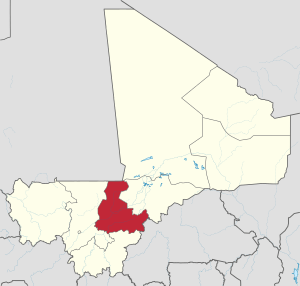Ségou Region facts for kids
Quick facts for kids
Ségou Region
|
|
|---|---|
|
Region
|
|

Location within Mali
|
|
| Country | |
| Capital | Ségou |
| Area | |
| • Total | 64,821 km2 (25,028 sq mi) |
| Population
(2009 census)
|
|
| • Total | 2,336,255 |
| • Density | 36.04164/km2 (93.3474/sq mi) |
| Time zone | UTC±0 (UTC) |
| HDI (2017) | 0.387 low · 4th |

The Ségou Region is a large administrative area in Mali, a country in West Africa. It is located right in the center of Mali. This region covers about 64,821 square kilometers. That is roughly 5% of Mali's total land.
Ségou Region shares its borders with several other areas. To the south, it meets the Sikasso Region. To the east, you will find the Tombouctou and Mopti regions. Burkina Faso is to the southeast. The Koulikoro Region is located to the west. In 2009, over 2.3 million people lived here. This made it the second most populated region in Mali. The main city and capital of the region is Ségou.
Contents
Geography and Climate
The Ségou Region is mostly flat land. It has a dry climate for much of the year. The Niger River flows through the region. This river is very important for farming and daily life. It brings water to many areas.
River and Waterways
The Niger River is a major feature of the Ségou Region. It provides water for irrigation. This helps farmers grow crops. The river also supports fishing. Many towns and villages are built along its banks.
Climate Patterns
The region experiences a Sahelian climate. This means it has a long dry season. There is also a shorter rainy season. Temperatures can get very hot, especially before the rains. The dry season often brings dusty winds.
People and Culture
Many different groups of people live in the Ségou Region. The Bamana are one of the largest groups. They have a rich history and culture. Other groups also contribute to the region's diverse traditions.
Languages Spoken
The official language of Mali is French. However, many local languages are spoken in Ségou. Bambara is the most common language. It is widely used in daily conversations.
Local Traditions
People in Ségou have strong traditions. Music and storytelling are very important. Festivals are held throughout the year. These events celebrate history and culture. They often involve traditional dances and songs.
Economy and Livelihoods
Farming is the main way people make a living in Ségou. The fertile land near the Niger River is perfect for growing crops. Other activities like fishing and trade are also important.
Agriculture in Ségou
Farmers in Ségou grow many different crops. Rice is a very important crop. It grows well in the areas near the river. Other crops include millet, sorghum, and cotton. These crops help feed the local population.
Trade and Markets
Markets are busy places in Ségou. People buy and sell goods there. Local crafts, food, and clothing are common items. Trade helps the economy grow. It also connects different communities.
History of Ségou
The Ségou Region has a long and interesting history. It was once home to powerful kingdoms. These kingdoms played a big role in West African history.
Bamana Empire
The Bamana Empire was a strong kingdom. It was based in Ségou. The empire existed from the 17th to the 19th century. It controlled trade routes and was known for its military power. The city of Ségou was its capital.
Colonial Period
Later, the region became part of French West Africa. This was during the time when European countries controlled parts of Africa. Mali gained its independence in 1960. Since then, Ségou has been a region of independent Mali.
Images for kids
See also
 In Spanish: Región de Segú para niños
In Spanish: Región de Segú para niños


